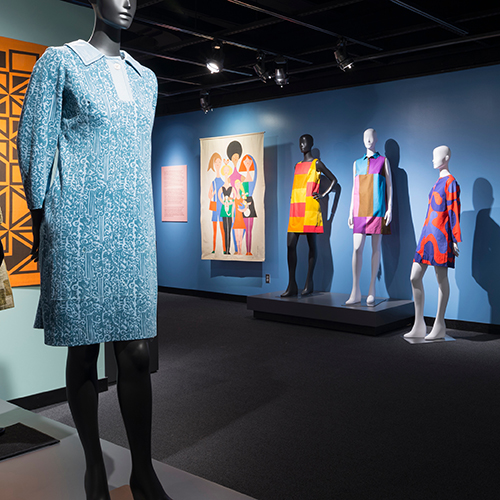Midcentury modern captures gallery space
Bold, colorful fashions and textiles. Harvest gold appliances. Shag carpet. These are icons of “midcentury modern” design that has seen a resurgence of popularity in recent years. The television series “Mad Men” played on this trend by meticulously recreating the fashion and styles of the 1960s and became a favorite of midcentury modern enthusiasts.
If you’re a fan of Mad Men and midcentury modern design, you will want to find your way to the new exhibit in the Robert Hillestad Textiles Gallery at the University of Nebraska-Lincoln’s East Campus. “Alexander Girard and Textile Design at Mid-Century” showcases fashion and design of the era and features the work of the renowned designer of textiles for the Herman Miller Company, where he was director of design for the textiles division from 1952-1973.
On exhibit are Girard’s wall hanging designs from the Herman Miller Action Office 2 line, that once graced the classrooms, offices and hallways of the Human Sciences Building . Called “environmental enrichment panels,” they were part of the interior decoration scheme when the building opened in 1974. At that time, the interior design program, now in the College of Architecture, was part of the Textiles department. Girard created more than 300 textile designs for Herman Miller and today the company continues to sell products that he designed. See http://go.unl.edu/girard.
“Time allows things to become new again and to be appreciated again,” says Mary Alice Casto, assistant professor in Textiles, Merchandising and Fashion Design (TMFD). “At a certain point, styles can go from being horribly outdated to appearing unique, interesting and special. Girard’s designs really hold up well and have re-emerged, but much of his work is really not dated at all. It still feels fresh.”

Casto and her colleagues in TMFD had been discussing Girard’s designs while taking down one of his pieces hanging in the department, to make way for remodeling a classroom. Girard’s panels were stored in TMFD’s textiles collection, so they decided to create the exhibit to display his designs, to feature the popularity of midcentury modern design, and to make connections between interior design and apparel design.
“Fashion is a driving force in interiors, electronics—all kinds of things—not just clothing,” said Casto. “In this exhibit, you see this connection between offices and homes; what we’re wearing and how they all work together.
“It’s fun, it’s bright, it’s colorful. If you’re interested in the history of the 50s and 60s, graphic design, textile design, clothing design, pattern and print, it’s definitely going to speak to you. You’ll see a lot of interesting ideas and places for inspiration.”
Vintage dresses from Finnish design house Marimekko and from Swedish fashion company Almedahl are also on display, to underscore the design connection between work spaces and personal fashion. The garments are part of the TMFD historic costume collection and were donated by, among others, the late Constance Kies, a professor for many years in Nutrition and Health Sciences.
“You can see the similarities in what was designed for the home or office and what women wore,” said Casto.

Casto explained that Girard used the blandness of modular design as a backdrop against which to express individuality and mood; to make a design statement. Textiles designed for apparel were also an expression of modernity, she noted. The association of modernity and “good” taste with the new textile patterns and fibers was a consistent feature in fashion magazines throughout the Postwar era. These modern patterns and colors for apparel demonstrate the same emphasis on stylized geometric shapes and bold color combinations found in Girard’s work. In fact, Casto said, fashion and interior textiles were sometimes featured together in advertising and promotional materials.
“He kept a nice balance in his use of colors, lines and shapes in his textiles,” said Casto. “He used a lot of neutral backgrounds and put color on top of them, which still really resonates well. He was doing ‘a pop of color’ long before that phrase became current.”
The Robert Hillestad Textiles Gallery is located on the second floor of the Human Sciences Building on East Campus. Hours are Monday-Friday, 8:30 a.m-4 p.m. and weekends by special request. There is never an admission charge. Call (402) 472-2911, for additional information or to request a weekend appointment.

